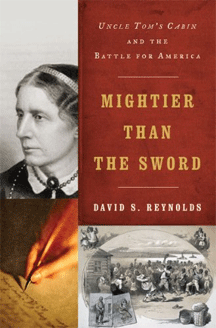By Louis J. Kern
In her preface to Dred: A Tale of the Great Dismal Swamp (1856), Harriet Beecher Stowe wrote,
“…never has there been a crisis in the history of this nation so momentous as the present. If ever a nation was…led forth upon a conspicuous stage, as if for the express purpose of solving a great moral problem in the sight of mankind, it is this nation….Is the system of slavery, as set forth in the American slave code right?”
David Reynolds in Mightier Than the Sword brilliantly illuminates the central role Stowe played as a catalyst, via her phenomenally popular novel, Uncle Tom’s Cabin; or, Life Among the Lowly (1852), in the resolution of that “great moral problem.”
The novel pierced the hearts, pricked the conscience, and touched the soul of multitudes of Americans . Its power, Reynolds argues, lay in combining an elevated moral fervor with popular cultural forms and attitudes. Read from a religious perspective, it brought together evangelical Protestantism, revivalist perfectionism, post-millenarianism, spiritualism, and an apocalyptic sense of foreboding. As a social text, it enabled both a conservative reading—emphasizing the moral authority of maternity, the sanctity of the family, domesticity, and the power of selfless love of humanity—and a more progressive one—stressing specific social reforms—temperance, moral reform (anti-prostitution and obscenity), and women’s rights. Stylistically, the novel combined elements of the gothic and romantic traditions with the sensationalism of what Reynolds calls “dark reform literature—that used reform themes to enable irrational, criminal, and sadistic passages and characterizations. The book also at once incorporated and challenged popular racial stereotypes, minstrel show humor, elements of the lurid penny press, and conventional themes from pulp fiction. In sum, Uncle Tom’s Cabin was an ideal vehicle to touch the conscience of the nation, to promote as Stowe put it, “the ENTIRE ABOLITION OF SLAVERY THROUGHOUT AMERICA AND THROUGHOUT CHRISTENDOM.”
In contrast with many contemporary political historians, who downplay the role of the novel in precipitating the Civil War and emancipation, Reynolds argues that it was critical to unifying abolitionist sentiment, provoking pro-slavery solidification , and promoting widespread empathy for the enslaved. And its cultural work did not terminate with emancipation; it continued to play a role as the nation struggled with racial issues well into the Civil Rights era, as well as on the worldwide stage, contributing to the end of serfdom in Russia (1861), the abolition of slavery in Cuba and Brazil (1886), and the successful revolt of Cubans against Spain (1895-1898).
Reynolds also provides a detailed discussion of the cultural afterlife of the novel—the “Tom” plays, the “Tommers” (actors specializing in “Tom” roles), and “Tomitudes” (popular cultural artifacts that were tie-ins to characters in the novel and plays)—showing how the novel has penetrated American consciousness like no other literary work. But in doing so he may obscure the deep ambiguity about race that Stowe shared with her contemporaries and that continues to plague modern national consciousness. While she could forcefully argue the need for African-American education and apprenticeship, of universal humanity, in the closing pages of the novel she frankly advocates colonization of the freedmen in Africa, as she seems also to implicitly suggest in her preface. Perhaps, then, Reynolds is too sanguine in his evaluation of the long-term power of Stowe to secure, in her words, “the great principles of Christian brotherhood.”
Louis J. Kern (ΦBK, Clark University,1965) is a professor of history at Hofstra University and a resident member of the Omega of New York chapter of Phi Beta Kappa.




